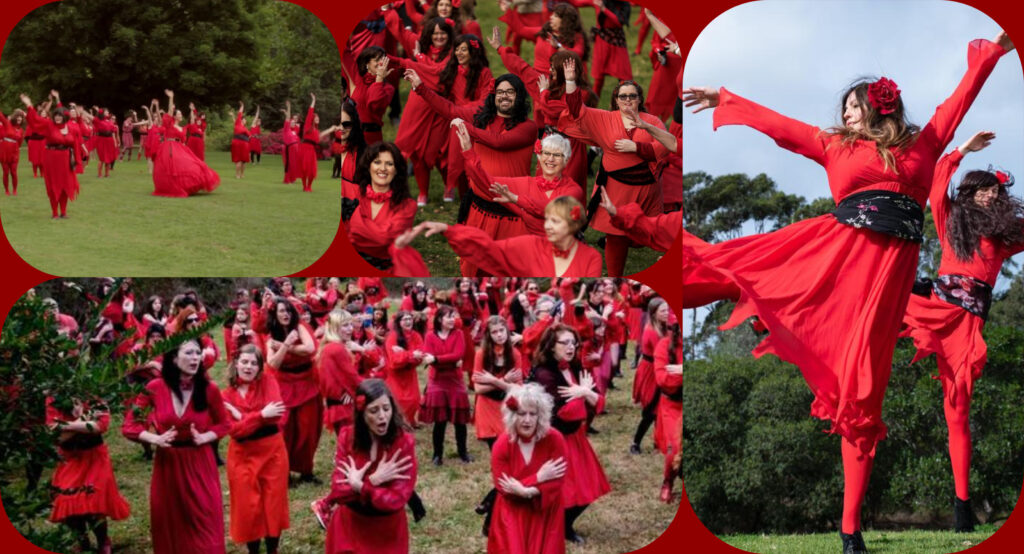
- Culture
-
by John Pot

Once when I was a high schooler, my friends gathered outside my bedroom window one morning and broke out in a shrill chorus of Kate Bush’s iconic Wuthering Heights (they wanted me to let them into my window-oh-oh-oh). I talked about Kate Bush a lot (who, by the way, could be the lion, the witch, as well as the wardrobe) so I deserved it. In reality, my enthusiasm for her music was the smallest factor. The Kate Bush-mania among my high school friends happened for the same reason as the current Stranger Things-fueled Kate Bush renaissance: she made a deal with God (sorry, I couldn’t resist) she’s a genius.
This is the song that has blasted her back into the cultural spotlight thanks to its appearance in the fourth season of Stranger Things. As I’m writing this, her masterpiece is in the #2 spot on the charts and most likely headed to #1; it’s currently the top contender on both the Global Spotify Chart and iTunes. Besides that, it’s topping charts all over the world and internet, and several other Kate Bush hits are climbing back up the ranks. It’s certainly set to continue, with the people at Stranger Things having mentioned that Running Up That Hill is going to take the stage again in season 5. All of this comes not long after a hitherto unreleased collaboration between Kate and rapper Big Boi (at his behest, no less), who has proclaimed his admiration for her before. Who knows if we’ll ever hear what they recorded, but I’m holding onto the hope that we might get to see some more of her soon!
It’s up to each listener to decide what makes Running Up That Hill brilliant (or why they don’t like it, which is equally valid), but it’s worth considering it’s place in in Kate’s career. It’s the first track on her critically acclaimed fifth studio album, Hounds of Love (1985). Where Hounds of Love is widely considered her best album, the one prior, The Dreaming (1982), is thought of as containing her most experimental work. Although it’s non-commercial sound echoed in its relatively low sales, it’s by no means bad and marks Kate’s forays into prog rock as well as being her first solo-produced album, recorded in her very own studio.
That said, Running Up That Hill represents a maturation of Kate’s music—a consolidation of four album’s worth of practice, new elements to her sound, and experience as a solo producer.
Sound aside, the music video is an artwork in its own right. Though choreographed by Diane Grey, Kate naturally had a hand in its design. Performing a classically-inspired routine with Michael Hervieu, her training in interpretive dance and mime gave her movements an edge. In fact, here mime teacher, Adam Darius, is the subject of the first song on her first album, The Kick Inside, released in 1978.
Moving stranger, does it really matter?
As long as you’re not afraid to feel
Touch me, hold me, how my open arms ache
Try to fall for me
With the first four lines of her studio career, Kate invites you into her music—or so I like to think, anyway. Greeting your debut album’s listener’s with whale song is a pretty big dick move, and with Moving‘s mellow bass line and steady beat it’s the perfect number to open with. I felt it’s an important piece to showcase, but what I really want to talk about is the song that truly catapulted Kate Bush into the public eye; its music video that annually compels people of all genders and ages to put on red dresses and gather in fields to perform the iconic dance as one; the book-to-music adaption that certainly has Emily Brontë rolling in her grave: Wuthering Heights.
Regarding the high school friends who woke me up with their horrible cover of this: once upon a time in university I went up to Joburg to visit two of them and got acquainted with some of their friends; it was only a matter of time before I played them this song. The overwhelming response was “creative but too shrill to really enjoy”, and that’s understandable. Her early career is characterized by her reaching high up in her vocal range and it can be an acquired taste; in Wuthering Heights she takes it to the extreme for her portrayal of the ghost, Catherine (fun fact: Kate, or Catherine, Bush shares not only her name with Brontë’s character, but also her birthday with Brontë herself). However you feel about her voice, it’s striking and made Kate the first female artist to top the UK charts with a self-written song (which she composed at the tender age of 18).

As you can see, the music video hit hard. I mentioned Kate’s training in dance and mime before, but what really stands out—especially in version 1, the one with the white dress—are her facial expressions, how she refuses to break eye contact. Her eyes confirm what she’s telling you in the lyrics, that she is there to grab your soul.
Before I move on from Kate Bush, I have to mention Yuri Kono. She’s a wildly talented musician and Kate Bush fan, and right now she’s covering each and every one of Kate’s songs in release order. Yuri manages what few covers can do by making the songs her own without letting it lose its essence. Like Kate, she’s not afraid to use her full vocal range, experiment with her cadences, improvise, and have fun with the music. In fact, and I know this is a bold statement, I prefer her cover of Full House, from the album Lionheart (1978), over the original.
Some of my other favourites of Yuri’s covers are In The Warm Room, also from Lionheart, and Egypt, from Never For Ever (1980). It’s also worthwhile checking out her own work, which evokes both traditional Japanese yōkyoku music and the stylings of the one and only Kate (seriously, this piece is phenomenal).
Lastly, just do yourself a favour and watch this brief video of Kate making tea like a wildperson:

Oh boy, where do I even begin with Suzanne Vega? Do I talk about Tom’s Diner, the first song on MP3 format, made even more famous by a cover collaboration with the no wave band DNA? Or perhaps you know her equally well-known Luka, the deceivingly upbeat song about an abused child, and it’s heart-wrenching sequel, Song of the Stoic, that I’m way too much of wuss to listen to (speaking of songs with sequels)? This article is already getting kind of long and there’s so much to cover—the scope of Suzanne Vega’s music is grand. Starting in 1985 with her self-titled album, she journeys through folk, rock, pop, the abstract and esoteric, jazz and blues, Broadway, and even a little bit of grunge.
When I gush about her music, I usually start with her writing. Her command of language is phenomenal, and she is especially adept at saying very much with few words, at putting complicated emotions into the simplest yet most powerful terms. Many of her songs are impressionistic, stirring up feeling with signal concepts and moments frozen in time.
I’d like to meet you
In a timeless, placeless place
Somewhere out of context
And beyond all consequences
Fitting for a song called Language, those four lines speak volumes. In just four lines she tells of a relationship that’s suffering from a breakdown in communication and understanding, of how she wishes that they could make things right by laying bare their true feelings without risking whatever is happening—or happened—to their bond; without language to complicate things:
I won’t use words again
They don’t mean what I meant
They don’t say what I said
Rosemary has probably my favourite example of Suzanne saying something deeply affecting in an almost casual way:
Those possibilities within her sight
With no way of coming true
Some things just don’t get through
Into this world, although they try
That’s something everyone can relate to on a variety of levels; it’s incredibly human, and that humanity is a hallmark of Suzanne’s music. Rosemary is to me one of her more impressionistic pieces in that it deals with feeling presented as moments, mundanities, and people.
Ironbound / Fancy Poultry is the first song that comes to mind when thinking about her impressionistic pieces; a series of vignettes, moments crystalized against the backdrop of life. In painting, impressionism often uses the mundane as a vehicle for emotion, relying on tone, composition, and detail to turn a random snapshot into something moving. Akin to this, it’s not just her carefully chosen words, but also her use of the music itself that imparts feeling. You’re might be thinking that I’m simply describing any song, but Suzanne takes it beyond just putting a melody to lyrics. In the song World Before Columbus, the bass line is played by a piano, lending its weightiness like heavy heartbeats to this song about deep love. In the “fancy poultry” part of Ironbound / Fancy Poultry, the guitar’s repeated triplets express what she’s singing: Nearly free… Nearly free… Nearly Free…
Speaking of killer bass lines, here she’s singing about her daughter (as in the aforementioned World Before Columbus), particularly giving birth to her, but—again thanks to her skill as a poet—the song could be about something completely different to someone else. To me it’s about standing up from your failings and persevering through tribulation. Suzanne’s music is highly accessible in this way, her relaxed vibratoless voice adding to that. I suppose its possible that sometimes she’s just being vague. The following song, The Queen and the Soldier, has many meanings—Suzanne herself doesn’t even know exactly what it’s about; I myself have about seven interpretations. However, it doesn’t matter what it means—this song is sad and beautiful and big, and my all time favourite.

Since I’m not the kind of writer who plans stuff out, I’m realising as I write this that I should be wrapping up, but I really want to talk about Jethro Tull. “I’ll make this brief” really isn’t the spirit with which to go into talking about Jethro Tull, after all, the band’s career spans 50 years and counting. I could just write a second draft or split the article up, but we could always look at it a little differently. Up to now I’ve been picking the songs, and given that Jethro Tull so often sings about adventure, I’ll play you my favourite and then leave the rest of the discovery up to you.


